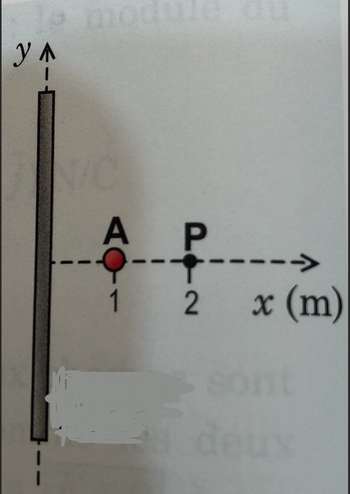Question
thumb_up100%
A uniformly charged infinite flat plate
A large, flat, uniformly charged plate is located in the xy-plane (it is seen from the side in the picture). A particle A whose charge is 5uC is placed at (x=1m; y=0). Knowing that the resulting electric field is zero at the point P of coordinates (x=2m; y=0), determine the surface charge density of the plate.

Transcribed Image Text:ул
module
>>>
AP
-+
1 2 x (m)
deus
Expert Solution
This question has been solved!
Explore an expertly crafted, step-by-step solution for a thorough understanding of key concepts.
Step by stepSolved in 2 steps with 2 images

Knowledge Booster
Similar questions
- Question 6 := Homework. Unanswered Multiple Plates -- Two infinite, uniformly charged plates have the same magnitude of surface charge density O. They are orientated in the illustration looking down the planes. Please note that is a positive value. Place your target in a region (inside a blue circle) of net electric field that points to the RIGHT. To do this, you will have to add two constant electric field vectors produced by the Then select the region where the net field points to the RIGHT. Figure [6.24]. planes for each region. 00 -0 Undo Delete selected Remove All o O Targets placed: 0/1 You can place up to 1 targetsarrow_forwardIn the figure a small circular hole of radius R = 1.55 cm has been cut in the middle of an infinite, flat, nonconducting surface that has a uniform charge density o = 6.33 pC/m². A z axis, with its origin at the hole's center, is perpendicular to the surface. What is the Z 2 = ( ₁ = √√²²+R² 1 and use superposition.) - magnitude of the electric field at point Pat z = 2.01 cm? (Hint: See equation E = X X X Number i 0.365 Units N/C or V/marrow_forwardPlease don't provide handwritten solution .....arrow_forward
- Find the magnitude of the electric field for r>barrow_forwardd Circular 3. Space vehicles traveling through Earth's radiation belts can intercept a significant number of electrons. The resulting charge buildup can damage electronic components and disrupt operations. Suppose a spherical metal satellite 1.3 m in diameter accumulates 2.4 μC of charge in one orbital revolution. (a) Find the resulting surface charge density. (b) Calculate the magnitude of the electric field just outside the surface of the satellite, due to the surface charge.arrow_forward
arrow_back_ios
arrow_forward_ios